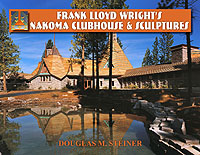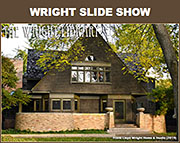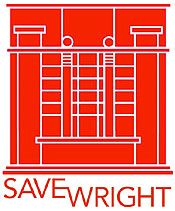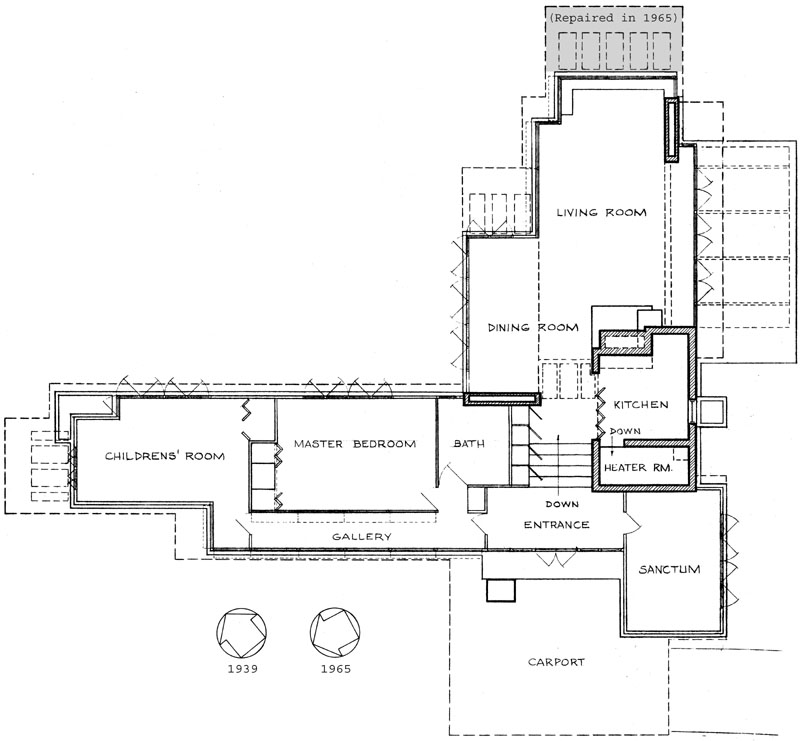|
|
|
Wright Studies
Loren B. Pope Residence,
Falls Church, Virginia (1939 - S.268) |
|
|
In April, 2006 on a trip to
Washington D. C. with our oldest grandson, we had the
opportunity to visit the Pope-Leighey House. The house has
rotated about 45 degrees during the 1965 reconstruction, so where the entrance faced
Southwest in 1939, it now faces Northwest. But I assume that
had to do with typography rather than lighting. Like many of
Wright's Usonian homes, it was an "L" shaped design based on
a 2x4 foot rectangular module. It was constructed of brick,
unfinished cypress and glass.
Ten years before our visit, the home was
moved again. Structural problems began to create cracks due
to the unstable soil under the home. In 1996, the home was
moved 30 feet away, where it sits today.
As you approach the home from the same
direction as in 1939, the Carport, it has been positioned on
a slope much like the original. Like many of Wright's
designs, the entrance is hidden, and is not revealed until
you reach the home. So you take a step of faith, not knowing
where, but knowing it is there.
Very little has sprouted during the
beginning of April, so the unfinished cypress blends with
the bare trees. The lack of |
|
windows on the approach reveals
little of the interior of the home. Perforated Light Screens
allow soft light into the home, adding a measure of privacy
and a decorative design element to the home.
The roof of the Carport cantilevers out 8'
6" at the front, is 19' wide, and cantilevers out from the
house 15' 6" in the back. The roof was designed with
three layers of 2x4's, each superimposed on top of the
other.
The Perforated Light Screens that run along
the top of the Gallery are 4' wide by approximately 11 -
11.5". The home was built on a Cherokee red concrete slab,
bordered in red brick. Embedded in the concrete was the
heating system, As Wright wrote in
The Natural House,
"...if your feet are warm, and you sit warm, you are
warm." p.159.
All doors and windows open outward and are
hung by piano hinges. Corners vanish when two corner windows are
opened. The horizontal Perforated Light Screens are hung
from the top.
The following is a set of eight photographs
of the Pope-Leighey House, by Douglas M. Steiner, April 7,
2006. Text and photographs by Douglas M. Steiner, Copyright
2015. |
|
|
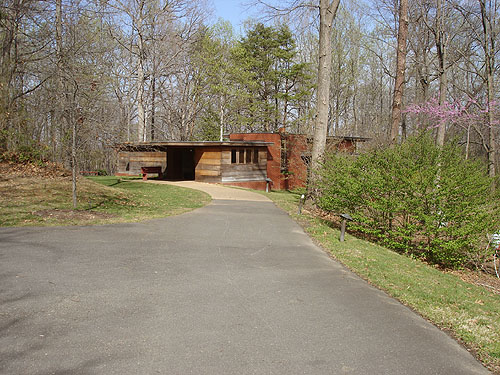 |
|
1) Pope-Leighey House 2006,
viewed from the Southwest, from the approach to the home.
The two Bedrooms are on the left, the Carport and Entrance
in the center, Sanctum (office), kitchen and Living Room are
on the right. It was constructed of brick, unfinished
cypress and glass. Photographed by and courtesy of Douglas
M. Steiner. (ST#2006.44.0815-1) |
|
|
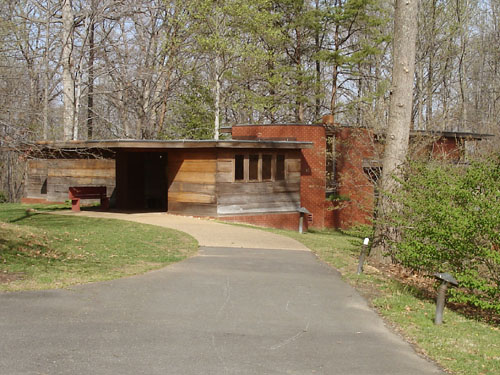 |
|
1A) Detail of the approach to the home.
The two Bedrooms are on the left, the Carport and Entrance
in the center, Sanctum (office), kitchen and Living Room are
on the right. |
|
|
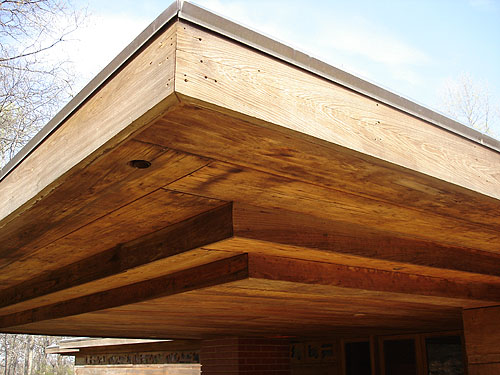 |
|
2) Pope-Leighey House 2006,
viewed from the Southwest. Detail of the construction of the
cantilevered Carport. Photographed by and courtesy of
Douglas M. Steiner. (ST#2006.44.0815-2) |
|
|
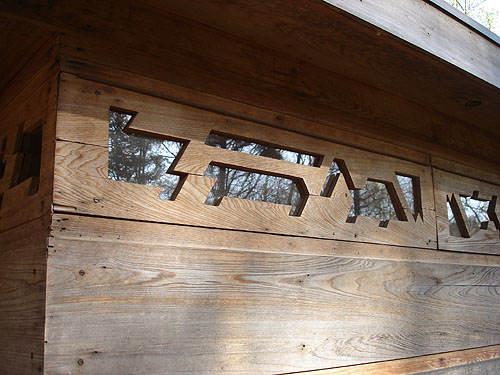 |
|
3) Pope-Leighey House 2006,
viewed from the North. Detail of the Northern corner of the
Gallery, and the Perforated Light Screen. Photographed by
and courtesy of Douglas M. Steiner. (ST#2006.44.0815-3) |
|
|
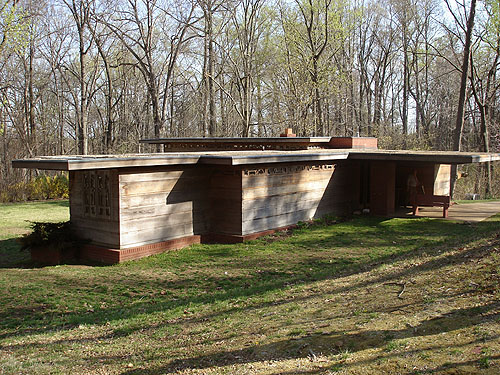 |
|
4) Pope-Leighey House 2006,
viewed from the North. The two bedrooms are in the
foreground wing. The row of Perforated Light Screen windows
that run the length of the Gallery, allow light in and also
a measure of privacy. The Entrance, Carport and Office are
to the right. The row of Perforated Light Screen Clerestory
windows of the Living and Dining Rooms can be seen in the
background. Like other Usonias, the homes are built on a
slap, have a flat roofs and built-in planters. Photographed
by and courtesy of Douglas M. Steiner. (ST#2006.44.0815-4) |
|
|
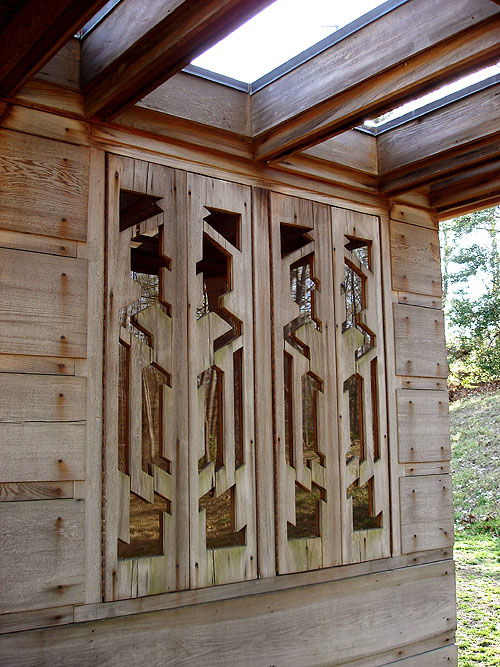 |
|
5) Pope-Leighey House 2006,
viewed from the Northeast. Detail of the decorative overhang
and the North end of the children's room. Photographed by
and courtesy of Douglas M. Steiner. (ST#2006.44.0815-5) |
|
|
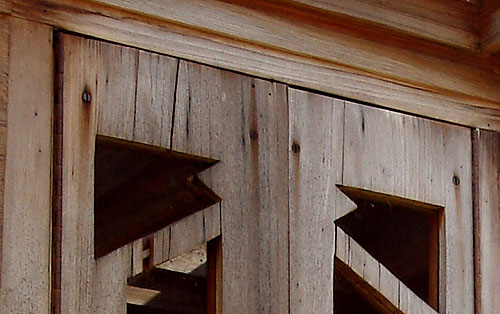 |
|
5A) Detail of the Perforated
Light Screen shutters.. |
|
|
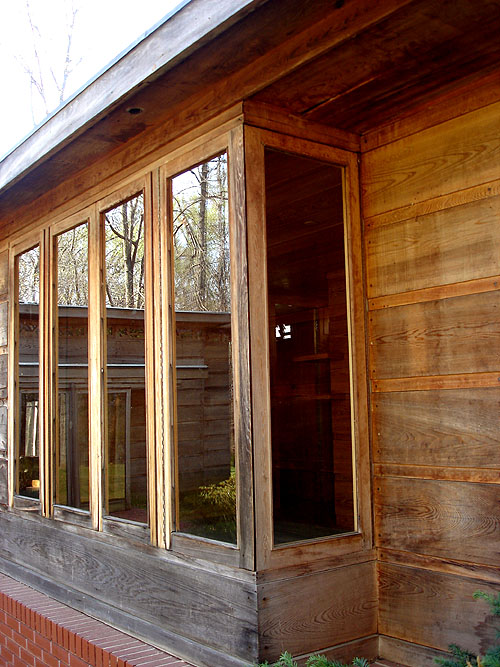 |
|
6) Pope-Leighey House 2006,
viewed from the Northeast. Detail of the children's room
windows. Four windows on the Southeast side open outward.
The two windows forming the corner also open outward,
eliminating the corner. Doors and windows are attached with
piano hinges. All exterior wood is left unfinished.
Photographed by and courtesy of Douglas M. Steiner.
(ST#2006.44.0815-6) |
|
|
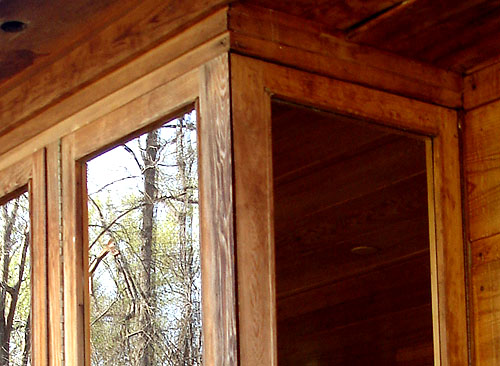 |
|
6A) Detail of the children's room
windows. The two windows forming the corner also open outward,
eliminating the corner. Doors and windows are attached with
piano hinges. |
|
|
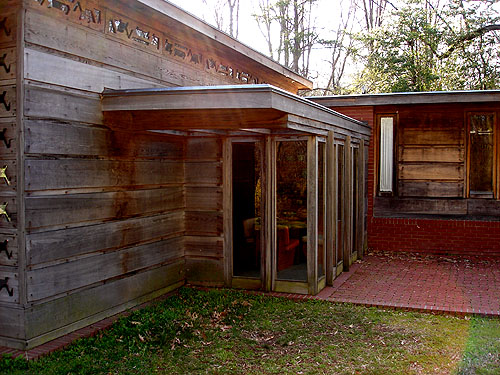 |
|
7) Pope-Leighey House 2006,
viewed from the East. The Living Room is on the left, Dining
Room in the center, Bath and Master Bedroom to the right.
Floor to ceiling doors open outward from the Dining Room.
Two doors forming the Northern corner of the Dining Room,
open outward, eliminating the corner. Doors and windows are
attached with piano hinges. All exterior wood is left
unfinished. Photographed by and courtesy of Douglas M.
Steiner. (ST#2006.44.0815-7) |
|
|
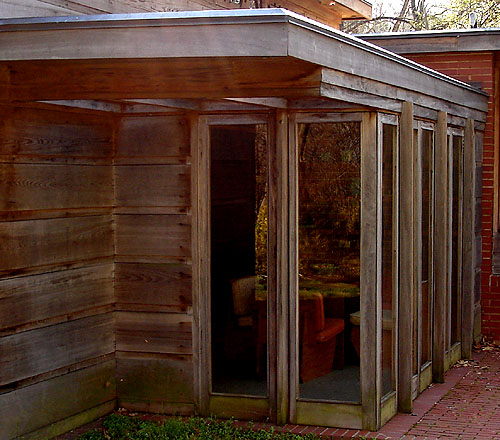 |
|
7A) Floor to ceiling doors open outward from the Dining Room.
Two doors forming the Northern corner of the Dining Room,
open outward, eliminating the corner. |
|
|
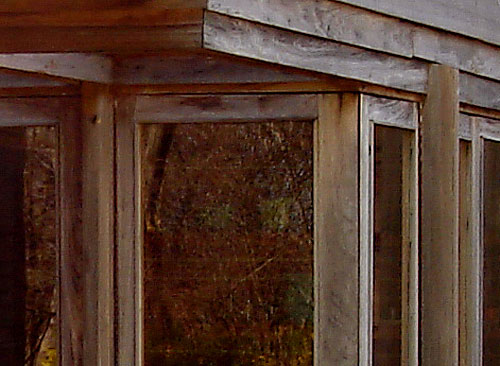 |
|
7B) Two doors forming the Northern corner of the Dining Room,
open outward, eliminating the corner. Doors and windows are
attached with piano hinges. |
|
|
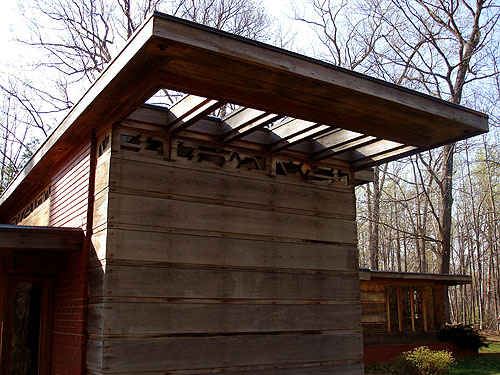 |
|
8) Pope-Leighey House 2006,
viewed from the Southeast. The trellised roof overhang adds
a decorative element to the design of the home, and allows
additional soft light to the Perforated Light Screens, into
the Living Room. The Living Room's screened Terrace is on
the left, the Bedroom wing is on the far right. Photographed
by and courtesy of Douglas M. Steiner. (ST#2006.44.0815-8) |
|
|
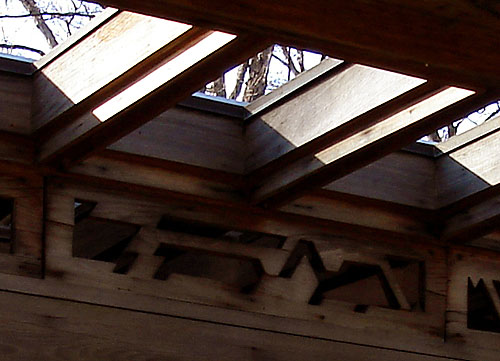 |
|
8A) Detail of the trellised
roof overhang which adds a decorative element to the design
of the home, and allows additional soft light to the
Perforated Light Screens, into the Living Room. |
|
|
|
Text and photographs by Douglas
M. Steiner, Copyright 2015. |
|
|
|
|
|
|
|
|
|
On April 7, 2015 nine years to
the day, we had the opportunity to visit the Pope-Leighey
Residence for the second time, on a trip to
Washington D. C. with our granddaughter.
The house has
rotated about 45 degrees during the 1965 reconstruction, so where the entrance faced
Southwest in 1939, it now faces Northwest. Like many of
Wright's Usonian homes, it was an "L" shaped design based on
a 2x4 foot rectangular module. It was constructed of brick,
cypress and glass.
Nineteen years before this visit, the home was
moved again. Structural problems began to create cracks due
to the unstable soil under the home. In 1996, the home was
moved 30 feet away, where it sits today. Third time is a
charm.
The home is situated on the Woodlawn
Plantation in Mount Vernon, but so seclude in the woods that
the four-lane road, only 300 feet away, is hidden from view.
The colors of the unfinished cypress and bricks blends with
the surroundings. Like other Usonians, the
homes are built on a slap, have a flat roofs and built-in
planters. The slab which the home is
built on is bordered in bricks.
The home slowly rises above
the ground as the ground slopes away from the home. Like many of Wright's
designs, the entrance is hidden, and is not revealed until
you reach the home. Four door panels make up the
Entrance. The two outside panels are fixed, the two center
doors are mounted with piano hinges and open outward. Doors and open outward. The cantilevered Carport shelters and hides the entrance. The roof of the Carport cantilevers out 8'
6" at the front, is 19' wide, and cantilevers out from the
house 15' 6" in the back. The roof was designed with three
layers of 2x4's, each superimposed on top of the other.
Horizontal cypress siding
measures 11 5/8" wide. The batten measures 2 1/4", with a
3/8" lip that sets into the upper groove, leaving 1 7/8"
exposed. Fascia measures 7 5/8". The siding is affixed with
screws and is left natural. "Mr. Wright's idea was that wood was its own best
preservative..."
The Pope-Leighey House, Morton, 1983, p.71. All screw slots are set
horizontally. "They were specified to be horizontal;
everything possible was horizontal. Mr. Wright felt that the
horizontal line conveyed a sense of unity with the earth."
Gordon Chadwick, apprentice |
|
assigned to the construction of
the Pope house, p.70.
The house cost $7,000 to
build. The red brick was chosen because it was the cheapest
available. Horizontal joints were raked, vertical joints
matched the color of the brick, and were flush with the
surface, p.67.
There are three cantilevered, trellised roofs,
the Children's Room, the Living and Dining Rooms. The Living
Room trellis was missing in 1964, but rebuilt in the 1965
relocation and renovation. They add a decorative element to the design of the home.
There is a fourth trellis in the Living Room, above the
stairs to the Entry.
The home
encompasses 1,200 square feet. To cool the home in the
summer, doors on either side of the Living and Dining Rooms
were left open, creating a cross ventilation, a natural air
conditioning.
The height of the ceiling in
the Living Room is 12 feet. Tidewater Red cypress was grown
and milled in Florida, then shipped to the lumber yard in
Baltimore by boat,
p.66-67. The interior wood was finished with Minwax, the
furniture finished with paste wax, P.71.The fireplace,
hearth, stairs and some of the walls were constructed of red
brick. A trellis over the stairs repeat the 2 x 4' pattern.
Perforated Light Screens defuse and soften the interior
light. The flow of the ceiling cypress in the Entryway, is
barely broken as it continues out over the Carport. Five
stairs lead from the Entry to the Kitchen (behind the
fireplace), Dining and Living Rooms. Built-in storage
cabinets are just to the right of the stairs. The ceiling
drops to a height of 7 feet in the Dining Room. Shelves are
cantilevered out from the brick wall secured by steel...
Three smaller Wright designed, square, freestanding tables
are combined to create the Dining Room Table. The Dining
Room chairs were designed by Wright, and used in many of the
Usonian homes. The beige and rose fabric pattern "Imperial
Triangle," was also specified in the Wright designed Nakoma
Clubhouse. End table mimic the design of the larger dining
tables. Chairs are placed in the living room.
The following is a set of 63 photographs
of the Pope-Leighey House, by Douglas M. Steiner, April 7,
2015. Text and photographs by Douglas M. Steiner, Copyright
2015. |
|
|
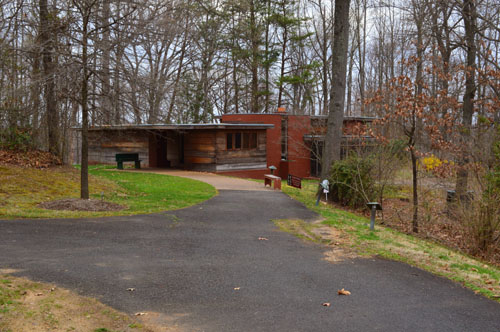 |
|
1) Pope-Leighey House 2015,
viewed on the approach from the Southwest. The home is
situated on the Woodlawn Plantation in Mount Vernon, but so
seclude in the woods that the four-lane road, only 300 feet
away, is hidden from view. It was constructed of brick,
unfinished cypress and glass. The two Bedrooms are on the
left, the Carport and Entrance in the center, Sanctum
(office), Kitchen and Living Room are on the right.
Photographed by and courtesy of Douglas M. Steiner.
(ST#2015.03.0815-1) |
|
|
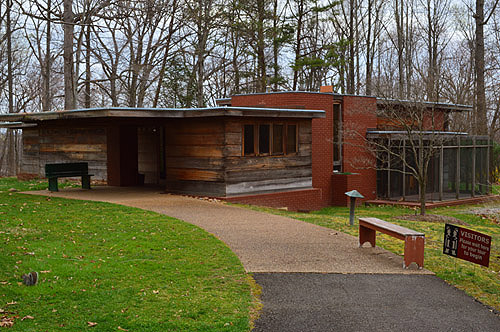 |
|
2) Pope-Leighey House 2015,
viewed from the Southwest. The colors of the unfinished
cypress and bricks blends with the surroundings. The two
Bedrooms are on the left, the Carport and Entrance in the
center, Office, Kitchen and Living Room are on the right.
Photographed by and courtesy of Douglas M. Steiner.
(ST#2015.03.0815-2) |
|
|
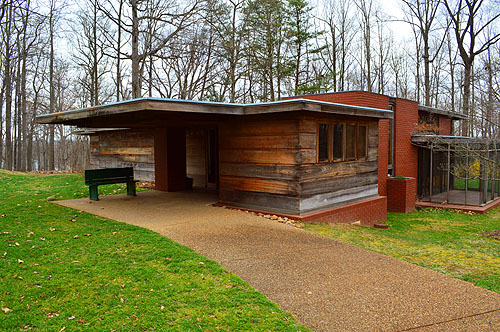 |
|
3) Pope-Leighey House 2015,
viewed from the Southwest. Two Bedrooms are on the left, the
Carport and Entrance in the center, Office, Kitchen and
Living Room are on the right. The screened terrace off the
Living Room is on the far right. Photographed by and
courtesy of Douglas M. Steiner. (ST#2015.03.0815-3) |
|
|
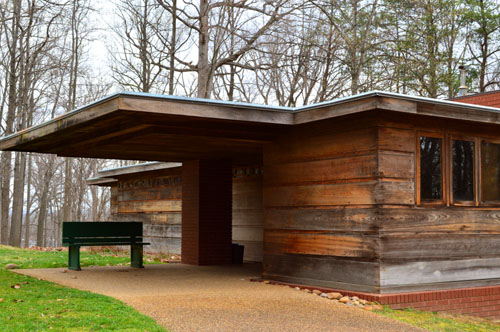 |
|
4) Pope-Leighey House 2015,
viewed from the Southwest. The roof of the Carport
cantilevers out 8' 6" at the front, is 19' wide, and
cantilevers out from the house 15' 6" in the back. Two
Bedrooms are on the left, the Carport and Entrance in the
center, the Office is on the right. Photographed by and
courtesy of Douglas M. Steiner. (ST#2015.03.0815-4) |
|
|
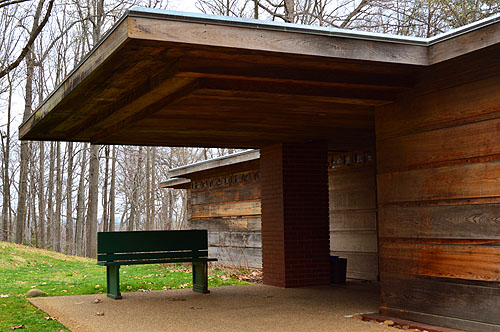 |
|
5) Pope-Leighey House 2015,
viewed from the Southwest. The roof was designed with three
layers of 2x4's, each superimposed on top of the other. Two
Bedrooms are on the left, the Carport and Entrance in the
center, the Office is on the right. Photographed by and
courtesy of Douglas M. Steiner. (ST#2015.03.0815-5) |
|
|
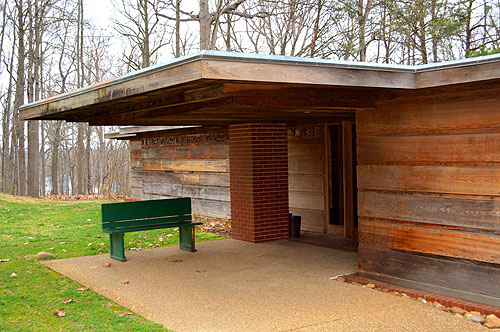 |
|
6) Pope-Leighey House 2015,
viewed from the West. In 1996, the home was moved 30 feet
away, where it sits today. Structural problems began to
create cracks due to the unstable soil under the home. Two
Bedrooms are on the left, the Carport and Entrance in the
foreground, the Office is on the right. Photographed by and
courtesy of Douglas M. Steiner. (ST#2015.03.0815-6) |
|
|
 |
|
7) Pope-Leighey House 2015,
viewed from the West. Like many of Wright's designs, the
entrance is hidden, and is not revealed until you reach the
home. Two Bedrooms are on the left, the Carport and Entrance
in the foreground, the Office is on the right. Photographed
by and courtesy of Douglas M. Steiner. (ST#2015.03.0815-7) |
|
|
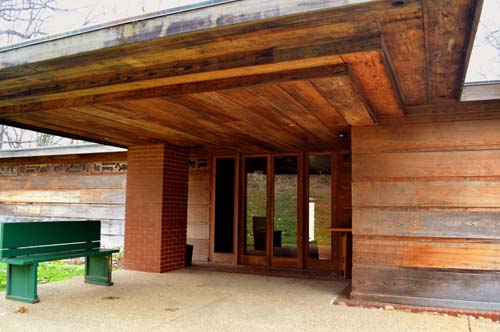 |
|
8) Pope-Leighey House 2015,
viewed from the West. Four door panels make up the Entrance.
The two outside panels are fixed, the two center doors open
outward. The roof was designed with three layers of 2x4's,
each superimposed on top of the other. Photographed by and
courtesy of Douglas M. Steiner. (ST#2015.03.0815-8) |
|
|
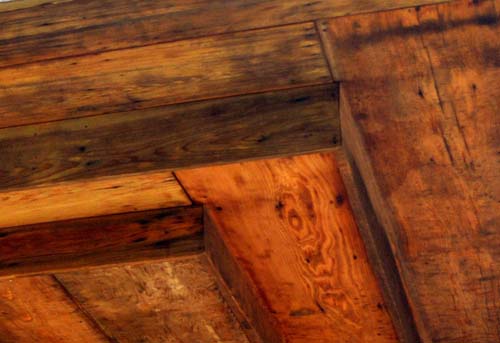 |
|
8A) Detail of the roof, designed with three layers of 2x4's,
each superimposed on top of the other. |
|
|
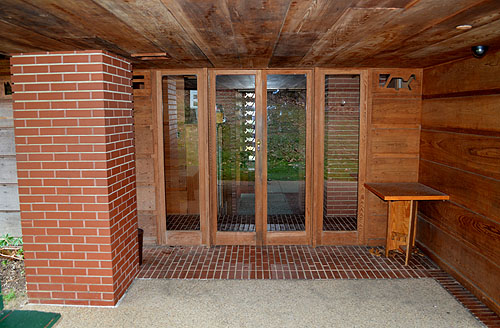 |
|
9) Pope-Leighey House 2015,
viewed from the Northwest. Four door panels make up the
Entrance. The two outside panels are fixed, the two center
doors open outward. The column on the left and a portion of
the entry way door is of brick. Perforated Light Screens
that run the length of the Gallery on the left, continues to
the right of the entryway. A Wright designed end table sits
to the right of the Entry. The Office is to the right.
Photographed by and courtesy of Douglas M. Steiner.
(ST#2015.03.0815-9) |
|
|
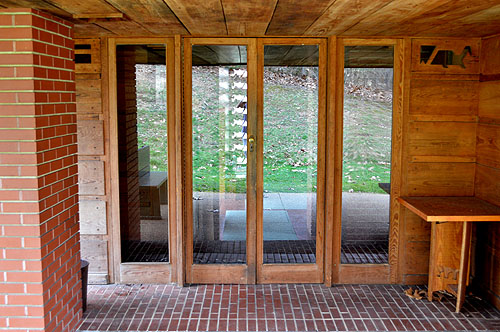 |
|
10) Pope-Leighey House 2015,
viewed from the Northwest. Detail of the Entry. Photographed
by and courtesy of Douglas M. Steiner. (ST#2015.03.0815-10) |
|
|
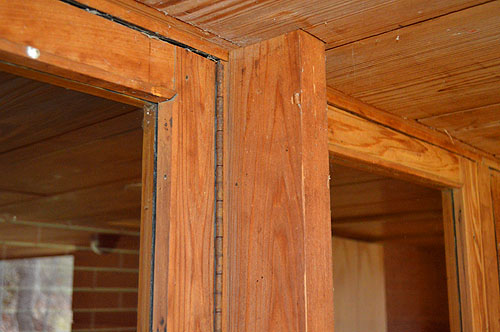 |
|
11) Pope-Leighey House 2015.
Detail of the entry way door construction. Doors are mounted
with piano hinges and open outward. Photographed by and
courtesy of Douglas M. Steiner. (ST#2015.03.0815-11) |
|
|
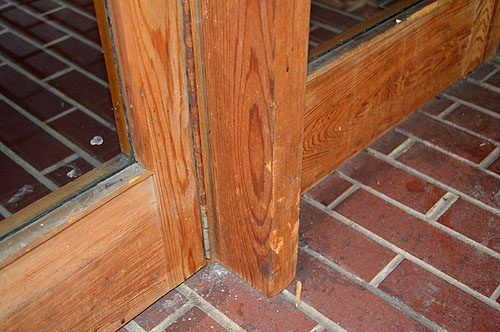 |
|
12) Pope-Leighey House 2015.
Detail of the entry way door construction. Doors are mounted
with piano hinges and open outward. Photographed by and
courtesy of Douglas M. Steiner. (ST#2015.03.0815-12) |
|
|
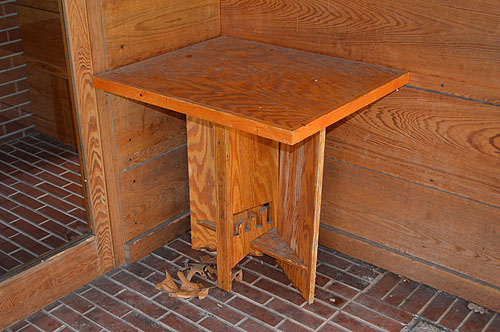 |
|
13) Pope-Leighey House 2015.
Wright designed end table sits to the right of the Entry.
Photographed by and courtesy of Douglas M. Steiner.
(ST#2015.03.0815-13) |
|
|
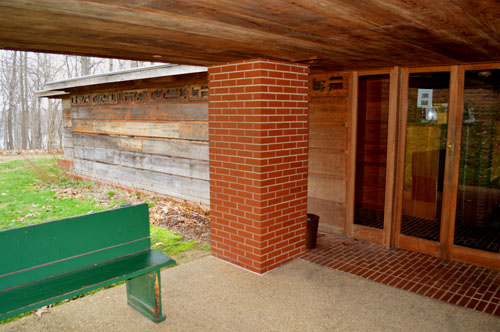 |
|
14) Pope-Leighey House 2015,
viewed from the Southwest. View of the Gallery on the left
from under the cantilevered carport. The row of Perforated
Light Screens that run the length of the Gallery, allows
light in and gives a measure of privacy. Photographed by and
courtesy of Douglas M. Steiner. (ST#2015.03.0815-14) |
|
|
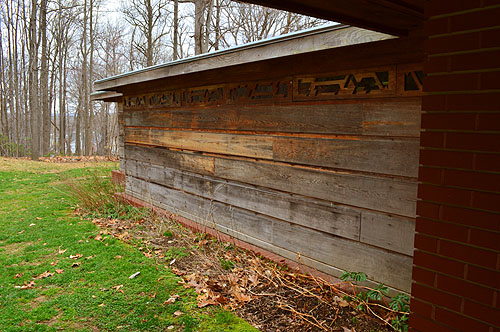 |
|
15) Pope-Leighey House 2015,
viewed from the Southwest. The Gallery runs from the Entry
to the Children's Room doorway. Perforated Light Screens
allow light in and offer a measure of privacy. Horizontal
cypress siding measures 11 5/8" wide. The batten measures 2
1/4", with a 3/8" lip that sets into the upper grove,
leaving 1 7/8" exposed. Photographed by and courtesy of
Douglas M. Steiner. (ST#2015.03.0815-15) |
|
|
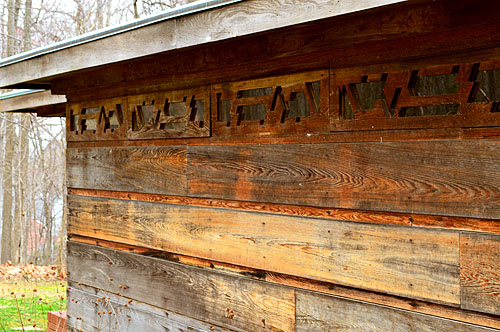 |
|
16) Pope-Leighey House 2015,
viewed from the Southwest. Detail of the Gallery that runs
from the Entry to the Children's Room doorway. Photographed
by and courtesy of Douglas M. Steiner. (ST#2015.03.0815-16) |
|
|
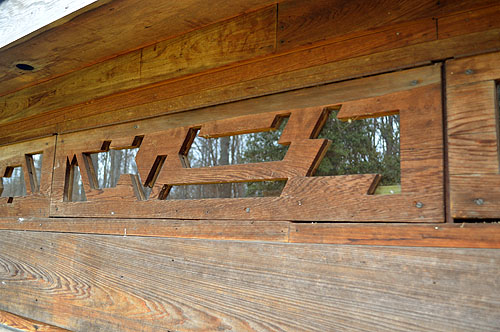 |
|
17) Pope-Leighey House 2015,
viewed from the Southwest. Detail of the Perforated Light
Screens. Screens are mounted along the top with piano hinges
and open outward. Photographed by and courtesy of Douglas M.
Steiner. (ST#2015.03.0815-17) |
|
|
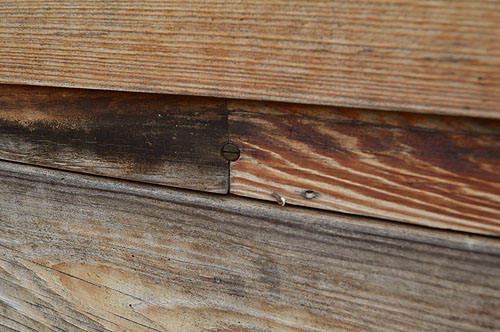 |
|
18) Pope-Leighey House 2015.
Detail of the cypress siding. Siding is affixed with screws.
All screw slots are set horizontally. "They were specified
to be horizontal; everything possible was horizontal. Mr.
Wright felt that the horizontal line conveyed a sense of
unity with the earth." Gordon Chadwick, apprentice assigned
to the construction of the Pope house.
The Pope-Leighey House, Morton, 1983, p.70.
Photographed by and courtesy of Douglas M. Steiner.
(ST#2015.03.0815-18) |
|
|
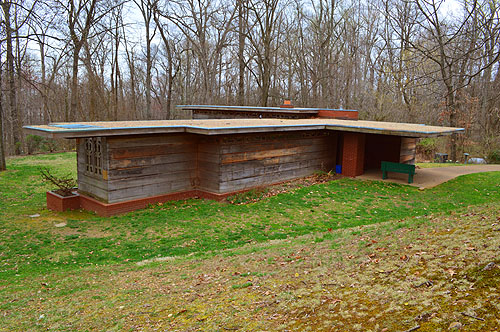 |
|
19) Pope-Leighey House 2015,
viewed from the North. The two bedrooms are in the
foreground wing. The row of Perforated Light Screen windows
that run the length of the Gallery, allow light in and a
measure of privacy. The Entrance, Carport and Office are to
the right. The row of Perforated Light Screen Clerestory
windows of the Living and Dining Rooms can be seen in the
background. Like other Usonians, the homes are built on a
slap, have a flat roofs and built-in planters. Photographed
by and courtesy of Douglas M. Steiner. (ST#2015.03.0815-19) |
|
|
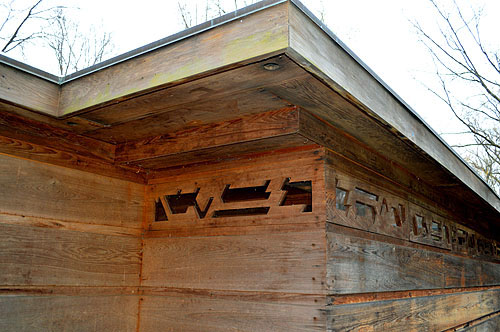 |
|
20) Pope-Leighey House 2015,
viewed from the North. Detail of the Northern corner of the
Gallery, and the Perforated Light Screen. Photographed by
and courtesy of Douglas M. Steiner. (ST#2015.03.0815-20) |
|
|
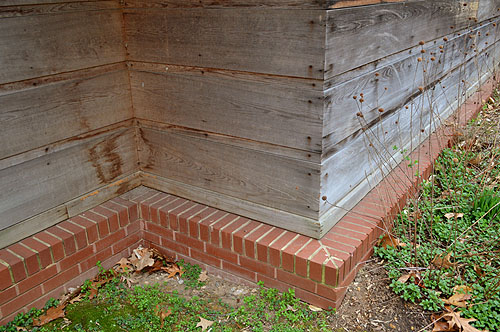 |
|
21) Pope-Leighey House 2015,
viewed from the North. Detail of the Northern corner of the
Gallery. The slab which the home is built on is bordered in
bricks. Photographed by and courtesy of Douglas M. Steiner.
(ST#2015.03.0815-21) |
|
|
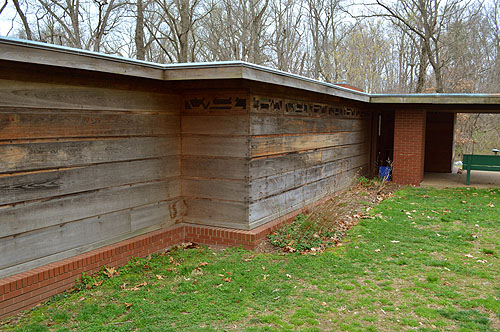 |
|
22) Pope-Leighey House 2015,
viewed from the North. The Children's Room is on the left,
the Gallery is in the center. The cantilevered Carport on
the right shelters and hides the entrance. Photographed by
and courtesy of Douglas M. Steiner. (ST#2015.03.0815-22) |
|
|
 |
|
23) Pope-Leighey House 2015,
viewed from the North. The home slowly rises above the
ground as the ground slopes away from the home. Photographed
by and courtesy of Douglas M. Steiner. (ST#2015.03.0815-23) |
|
|
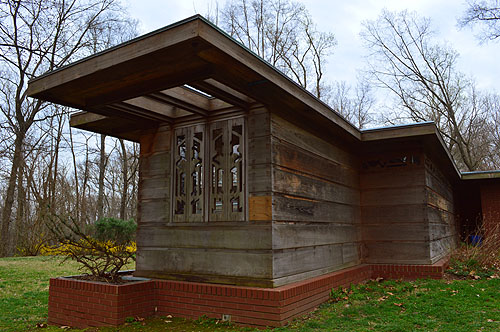 |
|
24) Pope-Leighey House 2015,
viewed from the North. The trellised roof cantilevers past
the end of the Children's Room. Perforated Light Screens are
turned 90 degrees and attached like window shutters. A
built-in planter is on the Eastern corner and blends home
with the earth. Photographed by and courtesy of Douglas M.
Steiner. (ST#2015.03.0815-24) |
|
|
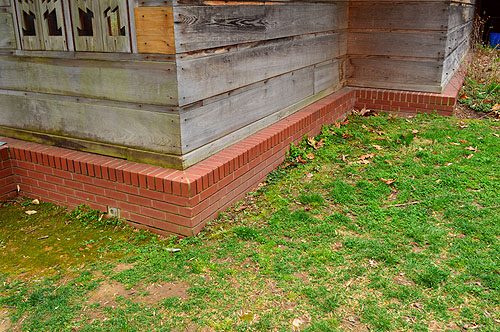 |
|
25) Pope-Leighey House 2015,
viewed from the North. Details of the bricks that border the
slab that the home is built on. Photographed by and courtesy
of Douglas M. Steiner. (ST#2015.03.0815-25) |
|
|
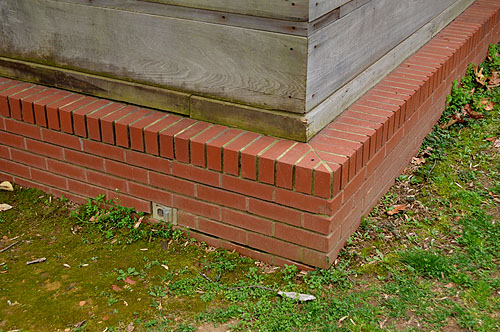 |
|
26) Pope-Leighey House 2015,
viewed from the North. Horizontal cypress siding measures 11
5/8" wide. The base shoe measures 3 1/2 inches plus a 5/16"
lip. Photographed by and courtesy of Douglas M. Steiner.
(ST#2015.03.0815-26) |
|
|
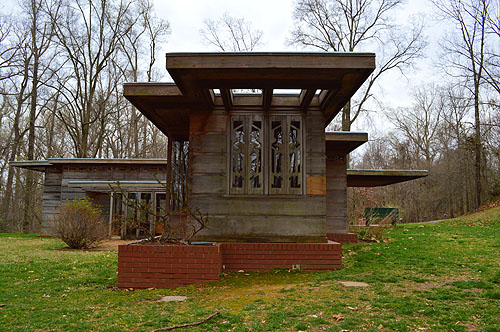 |
|
27) Pope-Leighey House 2015,
viewed from the North. The Living Room is on the far left,
the Children's Bedroom is in the foreground, the Carport is
on the right. Perforated Light Screens are turned 90 degrees
and attached like window shutters. A built-in planter is on
the Eastern corner of the Children's Bedroom. The trellised
roof cantilevers out past the end of the house. Photographed
by and courtesy of Douglas M. Steiner. (ST#2015.03.0815-27) |
|
|
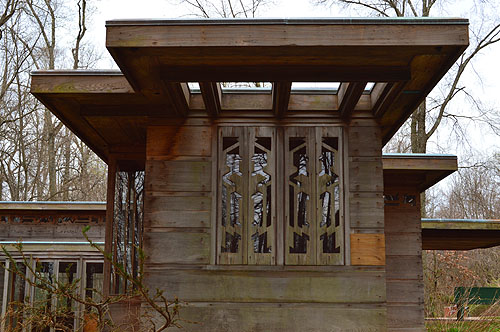 |
|
28) Pope-Leighey House 2015,
viewed from the North. All cypress siding is left natural.
Fascia measures 7 5/8". Photographed by and courtesy of
Douglas M. Steiner. (ST#2015.03.0815-28) |
|
|
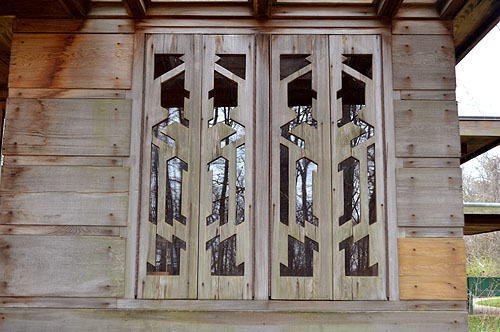 |
|
29) Pope-Leighey House 2015.
Detail of the Children's Room Perforated Light Screens.
Photographed by and courtesy of Douglas M. Steiner.
(ST#2015.03.0815-29) |
|
|
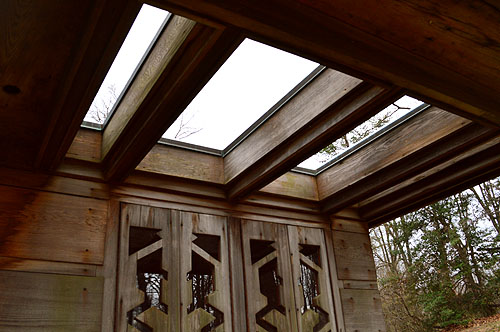 |
|
30) Pope-Leighey House 2015.
Detail of the Children's Room trellised roof which
cantilevers past the end of the house. Photographed by and
courtesy of Douglas M. Steiner. (ST#2015.03.0815-30) |
|
|
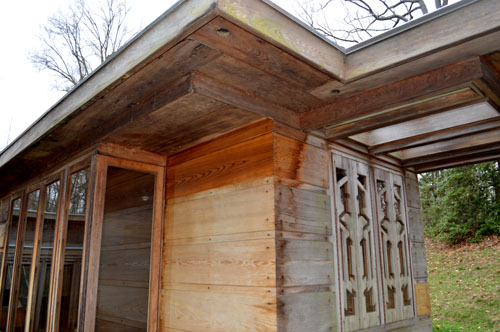 |
|
31) Pope-Leighey House 2015,
viewed from the Northeast. The five windows on the left are
hung with piano hinges and open outward. Photographed by and
courtesy of Douglas M. Steiner. (ST#2015.03.0815-31) |
|
|
 |
|
32) Pope-Leighey House 2015.
Detail of the built-in planter. Photographed by and courtesy
of Douglas M. Steiner. (ST#2015.03.0815-32) |
|
|
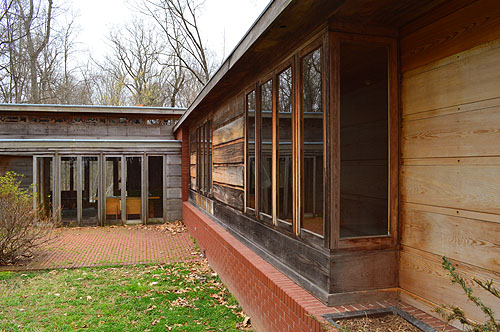 |
|
33) Pope-Leighey House 2015,
viewed from the Northeast. Detail of the children's room
windows. Four windows on the Southeast side open outward.
The two windows forming the corner also open outward,
eliminating the corner. Doors and windows are attached with
piano hinges. All exterior wood is left unfinished. The same
idea is followed on the left. The two doors forming the
corner of the Dining Room open outward, eliminating the
corner. Photographed by and courtesy of Douglas M. Steiner.
(ST#2015.03.0815-3) |
|
|
 |
|
34) Pope-Leighey House 2015,
viewed from the Northeast. The Master Bedroom windows are on
the left, the Children's Room windows are to the right. All
windows are hung by piano hinges and open outward.
Photographed by and courtesy of Douglas M. Steiner.
(ST#2015.03.0815-34) |
|
|
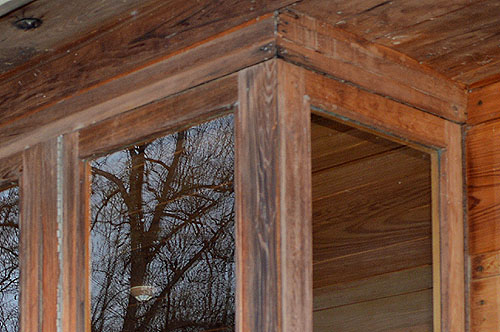 |
|
34A) Detail of the Children's Room windows.
The two windows forming the corner open outward, eliminating
the corner. |
|
|
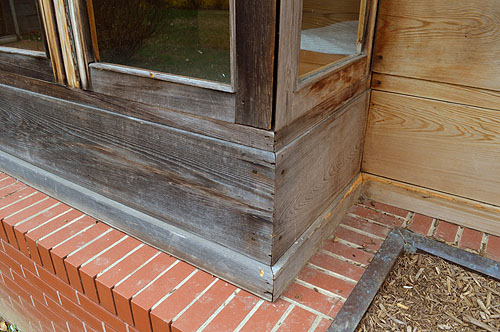 |
|
35) Pope-Leighey House 2015,
viewed from the Northeast. Detail of the Children's Room
corner. Photographed by and courtesy of Douglas M. Steiner.
(ST#2015.03.0815-35) |
|
|
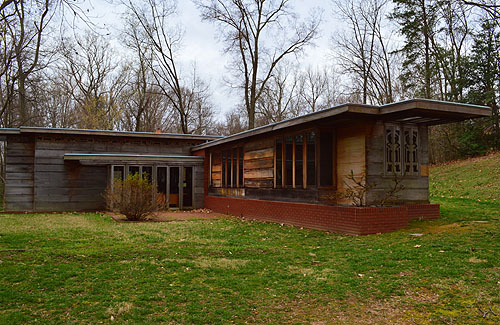 |
|
36) Pope-Leighey House 2015,
viewed from the Northeast. The Living and Dining Room wing
is on the left, the Bedroom wing is to the right. Ceilings
are 12' high in the living room and drop to 7 feet in the
Dining Room. Photographed by and courtesy of Douglas M.
Steiner. (ST#2015.03.0815-36) |
|
|
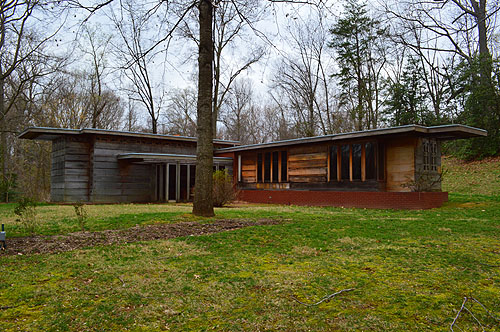 |
|
37) Pope-Leighey House 2015,
viewed from the Northeast. The Living and Dining Room wing
is on the left, the Bedroom wing is to the right. From the
Entry, five steps lead down to the Living, Dining and
Kitchen areas. The home encompasses 1,200 square feet.
Photographed by and courtesy of Douglas M. Steiner.
(ST#2015.03.0815-37) |
|
|
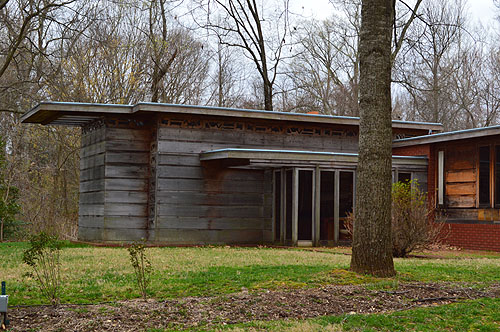 |
|
38) Pope-Leighey House 2015,
viewed from the Northeast. Two trellised roofs cantilever
past the end of the Living and Dining Rooms. The Living Room
trellis was removed by the 1964, rebuilt in the 1965
relocation and renovation. Photographed by and courtesy of
Douglas M. Steiner. (ST#2015.03.0815-38) |
|
|
 |
|
39) Pope-Leighey House 2015,
viewed from the East. Clerestory Perforated Light Screens
add soft light to the interior of the Living Room. Dining
Room doors open outward to the Terrace. The Master Bedroom
is on the right. Photographed by and courtesy of Douglas M.
Steiner. (ST#2015.03.0815-39) |
|
|
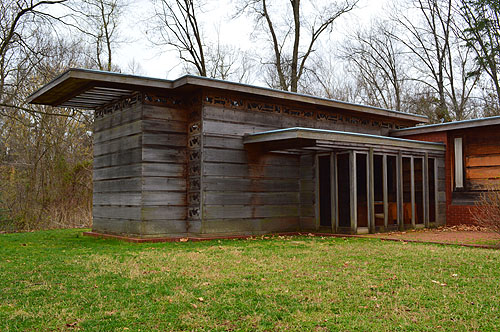 |
|
40) Pope-Leighey House 2015,
viewed from the East. Clerestory Perforated Light Screens
add soft light to the interior of the Living Room. Dining
Room doors open outward to the Terrace. Trellised roofs add
a decorative element to the design of the home. Photographed
by and courtesy of Douglas M. Steiner. (ST#2015.03.0815-40) |
|
|
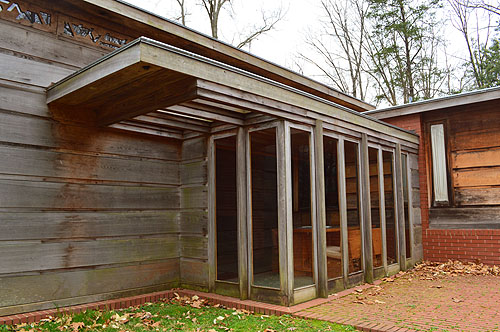 |
|
41) Pope-Leighey House 2015,
viewed from the East. The corner sets and two sets of doors
on the right open outward to the Terrace. All doors are hung
by piano hinges. Photographed by and courtesy of Douglas M.
Steiner. (ST#2015.03.0815-41) |
|
|
 |
|
41A) Detail of the Dining
Room Trellised Roof. |
|
|
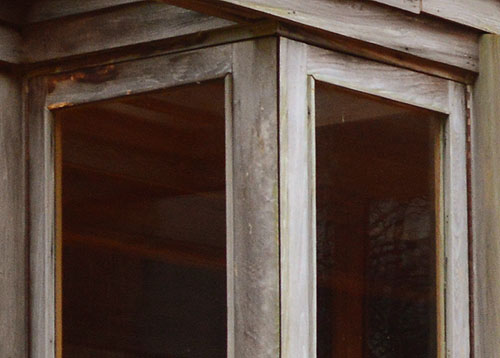 |
|
41B) The two doors forming
the corner open outward, eliminating the corner. |
|
|
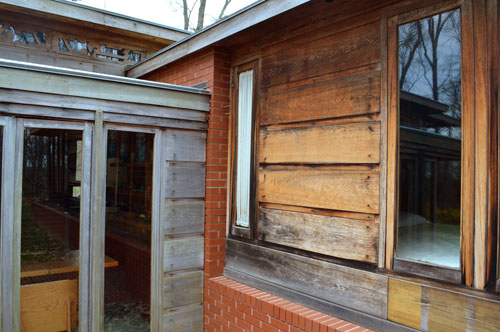 |
|
42) Pope-Leighey House 2015,
viewed from the East. The Dining Room is on the left, the
vertical window is the Bath, the Master Bedroom is on the
right. Photographed by and courtesy of Douglas M. Steiner.
(ST#2015.03.0815-42) |
|
|
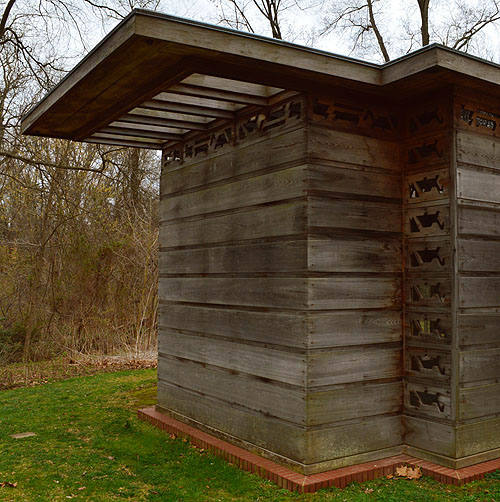 |
|
43) Pope-Leighey House 2015,
the Southeastern end of the Living Room viewed from the
East. Cypress siding is left unfinished. "Mr. Wright's idea
that wood was its own best preservative..."
The Pope-Leighey House, Morton, 1983, p.71.
Photographed by and courtesy of Douglas M. Steiner.
(ST#2015.03.0815-43) |
|
|
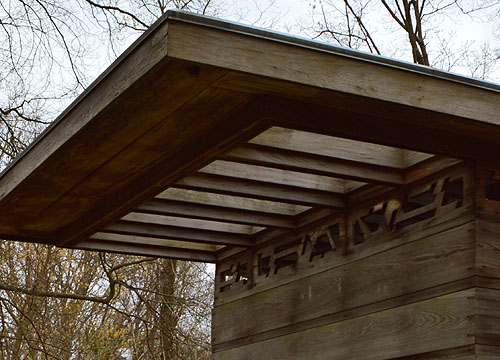 |
|
43A)
The Living Room trellis was
destroyed by Hurricane Hazel in 1954. It was restored to
original specifications during the reconstruction in 1965. |
|
|
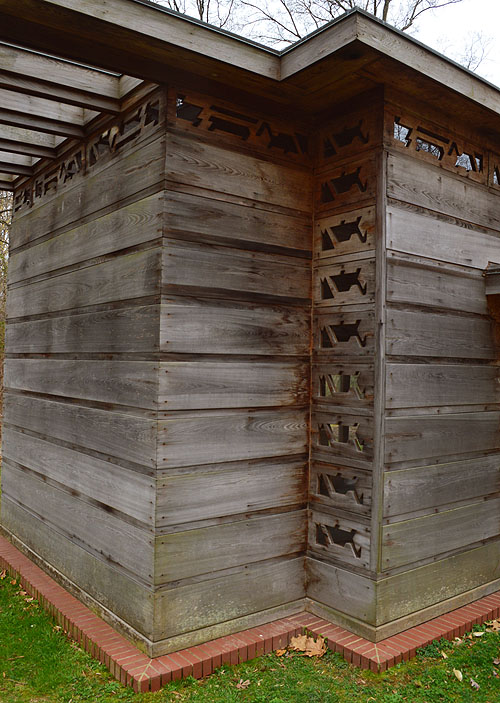 |
|
44) Pope-Leighey House 2015,
the Southeastern end of the Living Room viewed from the
East. Horizontal cypress siding measures 11 5/8" wide. The
batten measures 2 1/4", with a 3/8" lip that sets into the
upper groove, leaving 1 7/8" exposed. Nine short Perforated
Light Screens cover the short wall of the Living Room.
Photographed by and courtesy of Douglas M. Steiner.
(ST#2015.03.0815-44) |
|
|
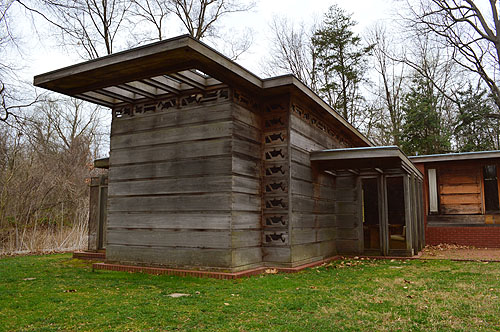 |
|
45) Pope-Leighey House 2015,
viewed from the East. To cool the home in the summer, doors
on either side of the Living and Dining Rooms were left
open, creating a cross ventilation, a natural air
conditioning. Photographed by and courtesy of Douglas M.
Steiner. (ST#2015.03.0815-45) |
|
|
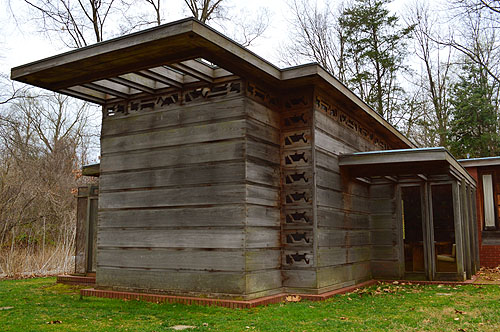 |
|
46) Pope-Leighey House 2015,
viewed from the East. The design was based on a 2x4 foot
rectangular module. Wall measurements, trellis shapes, door
widths, roof overhangs, all conform to the grid.
Photographed by and courtesy of Douglas M. Steiner.
(ST#2015.03.0815-46) |
|
|
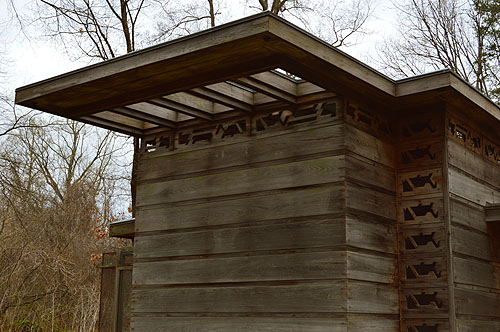 |
|
47) Pope-Leighey House 2015,
viewed from the East. Roof Trellis are based on 2 x 4
dimensions. Upper Perforated Light Screens are 4 feet wide.
The vertical row of Light Screens are two feet wide.
Photographed by and courtesy of Douglas M. Steiner.
(ST#2015.03.0815-47) |
|
|
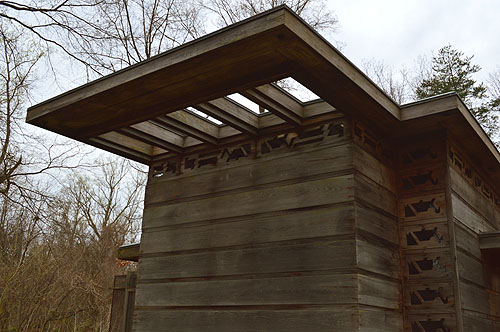 |
|
48) Pope-Leighey House 2015,
viewed from the East. This roof trellis was missing in 1964
images. It was resorted to this condition in the 1965
relocation and renovation. Photographed by and courtesy of
Douglas M. Steiner. (ST#2015.03.0815-4) |
|
|
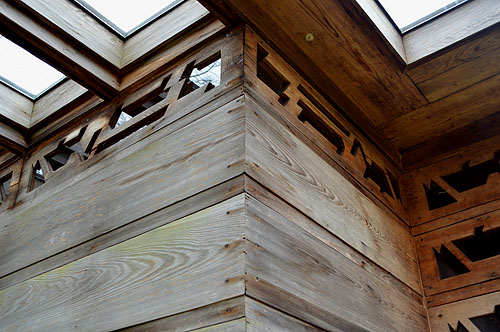 |
|
49) Pope-Leighey House 2015,
viewed from the East. Detail of the Eastern corner of the
Living Room. All screw slots are set horizontally. "They
were specified to be horizontal; everything possible was
horizontal. Mr. Wright felt that the horizontal line
conveyed a sense of unity with the earth." Gordon Chadwick,
apprentice assigned to the construction of the Pope house.
The Pope-Leighey House, Morton, 1983, p.70.
Photographed by and courtesy of Douglas M. Steiner.
(ST#2015.03.0815-49) |
|
|
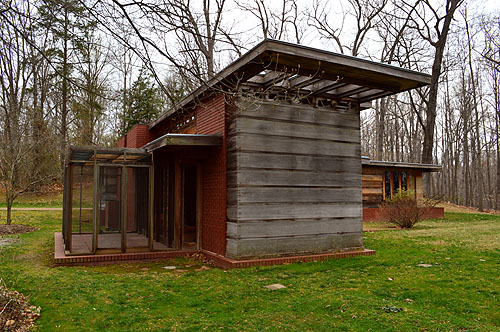 |
|
50) Pope-Leighey House 2015,
viewed from the Southeast. The trellised roof overhang adds
a decorative element to the design of the home, and allows
additional soft light to the Perforated Light Screens, into
the Living Room. The Living Room's screened Terrace is on
the left, the Bedroom wing is on the far right. Photographed
by and courtesy of Douglas M. Steiner. (ST#2015.03.0815-50) |
|
|
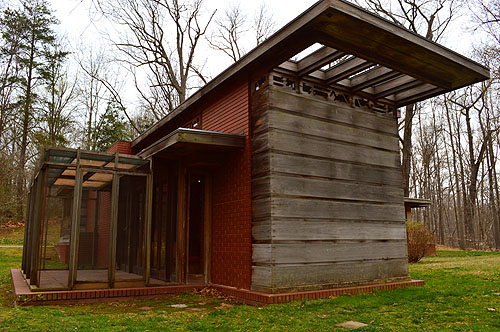 |
|
51) Pope-Leighey House 2015,
viewed from the Southeast. Doors open outward from the
Living Room to the Terrace. The screened Terrace is
constructed of wood, copper tubing and copper screen.
Photographed by and courtesy of Douglas M. Steiner.
(ST#2015.03.0815-51) |
|
|
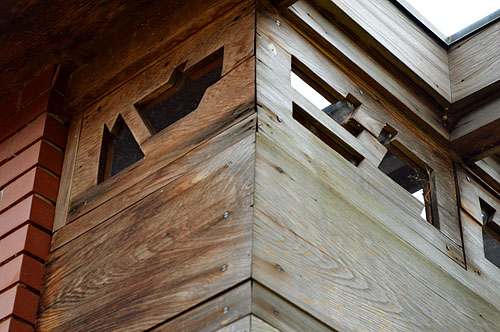 |
|
52) Pope-Leighey House 2015.
Detail of the Southern corner of the Living Room. Wright
takes a simple element like wood and creates a complex
design. Tidewater Red cypress was grown and milled in
Florida, then shipped to the lumber yard in Baltimore by
boat.
The Pope-Leighey House, Morton, 1983, p.66-67.
Photographed by and courtesy of Douglas M. Steiner.
(ST#2015.03.0815-5) |
|
|
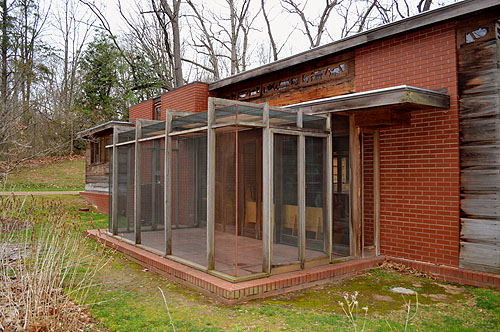 |
|
53) Pope-Leighey House 2015,
viewed from the South. The Office is on the far left,
Workspace (Kitchen) is two it's right, the Living Room to
the right. The house cost $7,000 to build. The red brick was
chosen because it was the cheapest available. Horizontal
joints were raked, vertical joints matched the color of the
brick, and were flush with the surface.
The Pope-Leighey House, Morton, 1983, p.67.
Photographed by and courtesy of Douglas M. Steiner.
(ST#2015.03.0815-53) |
|
|
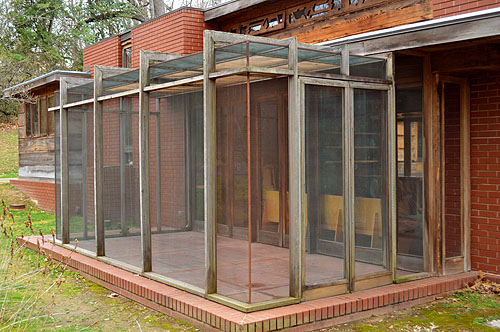 |
|
54) Pope-Leighey House 2015,
viewed from the South. With the use of thin copper tubing,
Wright was able to remove the wood structure from both
corners. The two screen doors on the right are hung with
piano hinges and open outward. Photographed by and courtesy
of Douglas M. Steiner. (ST#2015.03.0815-5) |
|
|
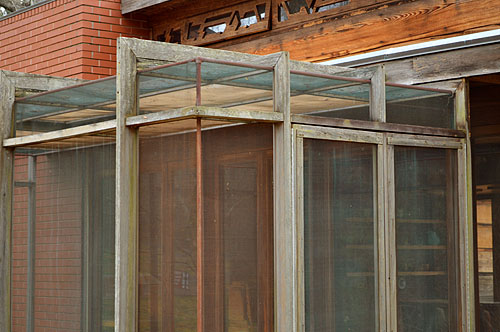 |
|
55) Pope-Leighey House 2015.
Detail of the screened patio construction. Photographed by
and courtesy of Douglas M. Steiner. (ST#2015.03.0815-55) |
|
|
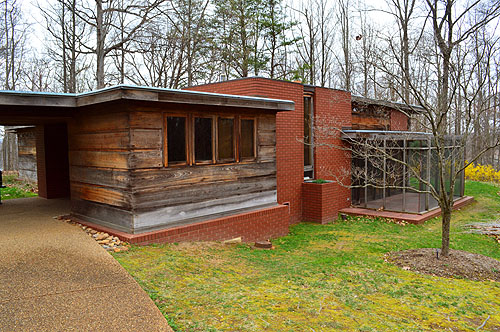 |
|
56) Pope-Leighey House 2015
viewed from the Southwest. The two Bedrooms are on the left,
the Carport and Entrance in the center, Office, Kitchen and
Living Room are on the right. There is a built-in planter
just outside the kitchen window. Photographed by and
courtesy of Douglas M. Steiner. (ST#2015.03.0815-5) |
|
|
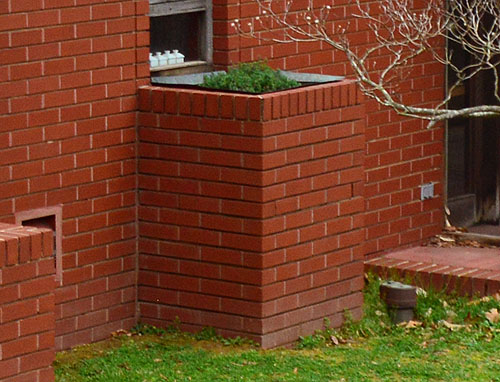 |
|
56A) Detail of the built-in
planter just outside the kitchen window. |
|
|
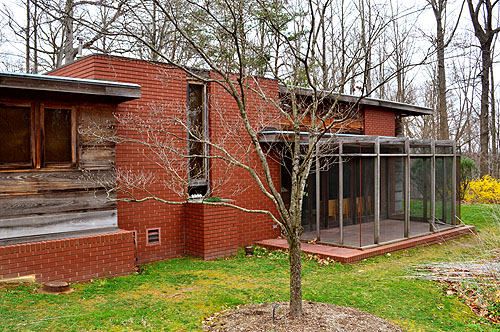 |
|
57) Pope-Leighey House 2015,
viewed from the Southwest. The home was built on a gentle
slope. The Office on the left is at the same level as the
Entrance and Bedrooms. From the Entry, five steps down leads
to the Kitchen, Living and Dining Room level. Photographed
by and courtesy of Douglas M. Steiner. (ST#2015.03.0815-57) |
|
|
 |
|
58) Pope-Leighey House 2015,
viewed from the Southwest. Three sets of doors lead out to
the screened patio. The walls of the Kitchen on the left are
constructed of brick, as is one wall of the Living Room on
the right. The design of the footprint is based on a 2x4
foot rectangular module which can be seen scored into the
patio concrete. The concrete floor is tinted Cherokee red.
Photographed by and courtesy of Douglas M. Steiner.
(ST#2015.03.0815-58) |
|
|
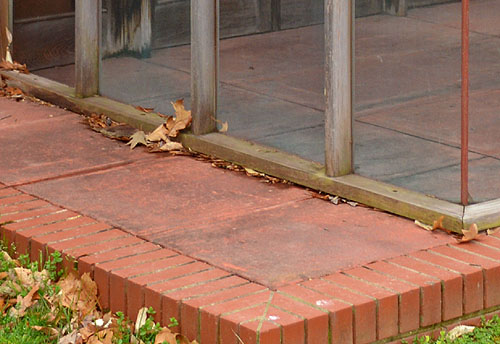 |
|
58A) The design of the
footprint is based on a 2x4 foot rectangular module which
can be seen scored into the patio concrete. The concrete
floor is tinted Cherokee red. |
|
|
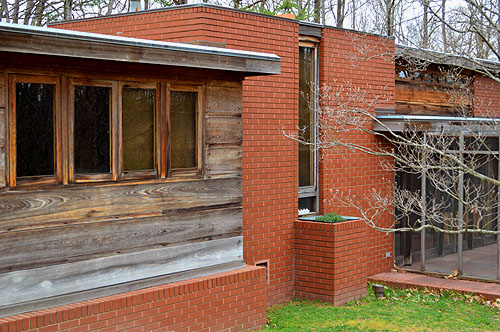 |
|
59) Pope-Leighey House 2015,
viewed from the Southwest. The tall Kitchen window is hung
by a piano hinge and opens outward. The top of the build-in
planter matches the height of the Kitchen counter.
Photographed by and courtesy of Douglas M. Steiner.
(ST#2015.03.0815-59) |
|
|
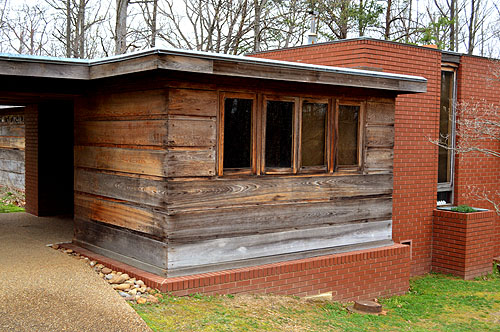 |
|
60) Pope-Leighey House 2015,
viewed from the Southwest. All four windows in the Office
are hung by piano hinges, but only the two center windows
open as a pair. The left window is hinged on the right, the
right window is hinged on the left. Photographed by and
courtesy of Douglas M. Steiner. (ST#2015.03.0815-6) |
|
|
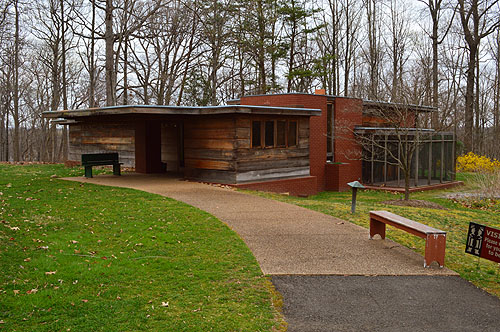 |
|
61) Pope-Leighey House 2015,
viewed from the Southwest. After fully viewing the exterior
of the house, we return back to the original entry way to
the home. Photographed by and courtesy of Douglas M.
Steiner. (ST#2015.03.0815-61) |
|
|
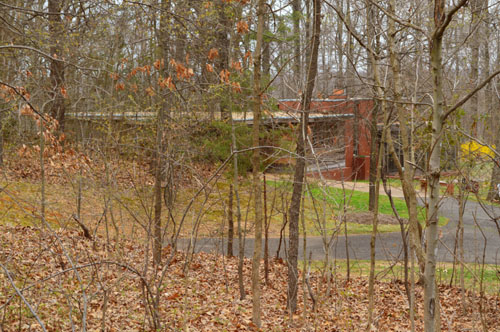 |
|
62) Pope-Leighey House 2015,
viewed from the West. The colors of the unfinished cypress
and bricks blends with the surroundings. Photographed by and
courtesy of Douglas M. Steiner. (ST#2015.03.0815-62) |
|
|
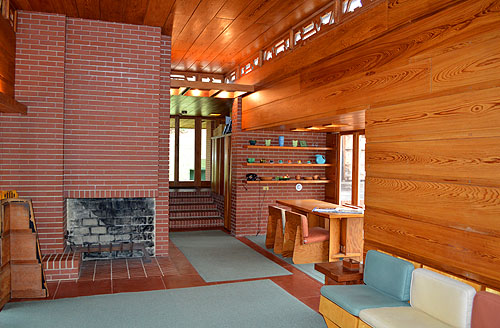 |
|
63) Pope-Leighey House 2015.
View of the Living and Dining room from the Southeast. The
height of the ceiling in the Living Room is 12 feet.
Tidewater Red cypress was grown and milled in Florida, then
shipped to the lumber yard in Baltimore by boat.
The Pope-Leighey House, Morton, 1983, p.66-67. The interior wood
was finished with Minwax, the furniture finished with paste
wax, P.71.The fireplace, hearth, stairs and some of the
walls were constructed of red brick. A trellis over the
stairs repeat the 2 x 4' pattern. Perforated Light Screens
defuse and soften the interior light. The flow of the
ceiling cypress in the Entryway, is barely broken as it
continues out over the Carport. Five stairs lead from the
Entry to the Kitchen (behind the fireplace), Dining and
Living Rooms. Built-in storage cabinets are just to the
right of the stairs. The ceiling drops to a height of 7 feet
in the Dining Room. Shelves are cantilevered out from the
brick wall secured by steel... Three smaller Wright
designed, square, freestanding tables are combined to create
the Dining Room Table. The Dining Room chairs were designed
by Wright, and used in many of the Usonian homes. The beige
and rose fabric pattern "Imperial Triangle," was also
specified in the Wright designed Nakoma Clubhouse. End table
mimic the design of the larger dining tables. Chairs are
placed in the living room instead of built-in seating.
Photographed by and courtesy of Douglas M. Steiner.
(ST#2015.03.0815-63) |
|
|
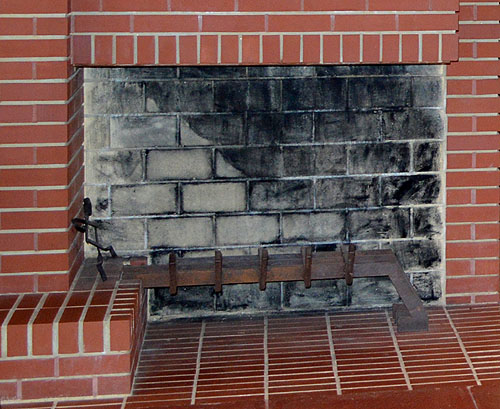 |
|
63A) The fireplace, hearth,
stairs and some of the walls were constructed of red brick.
|
|
|
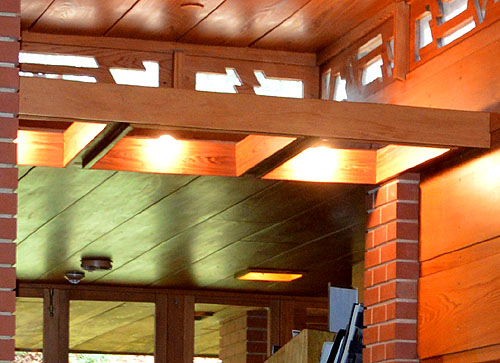 |
|
63B) A trellis over the
stairs repeat the 2 x 4' pattern. Perforated Light Screens
defuse and soften the interior light. The flow of the
ceiling cypress in the Entryway, is barely broken as it
continues out over the Carport. Five stairs lead from the
Entry to the Kitchen (behind the fireplace), Dining and
Living Rooms. |
|
|
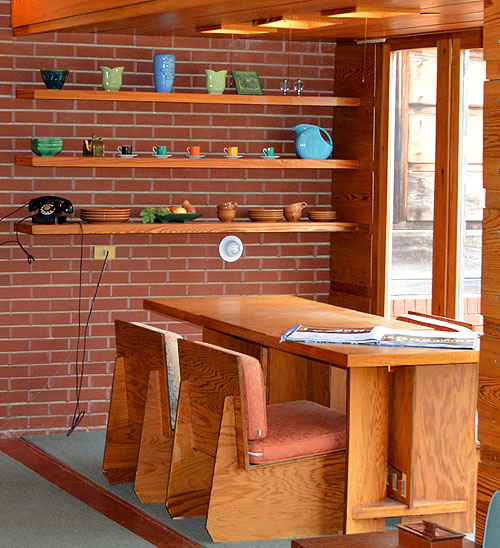 |
|
63C) The ceiling drops to a
height of 7 feet in the Dining Room. Shelves are
cantilevered out from the brick wall secured by steel...
Three smaller Wright designed, square, freestanding tables
are combined to create the Dining Room Table. The Dining
Room chairs were designed by Wright, and used in many of the
Usonian homes. The beige and rose fabric pattern "Imperial
Triangle," was also specified in the Wright designed Nakoma
Clubhouse. See additional Wright
Chairs... |
|
|
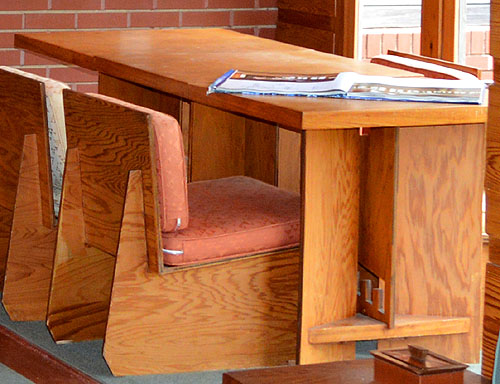 |
|
63D) Three smaller Wright
designed, square, freestanding tables are combined to create
the Dining Room Table. The Dining Room chairs were designed
by Wright, and used in many of the Usonian homes. The beige
and rose fabric pattern "Imperial Triangle," was also
specified in the Wright designed Nakoma Clubhouse.
|
|
|
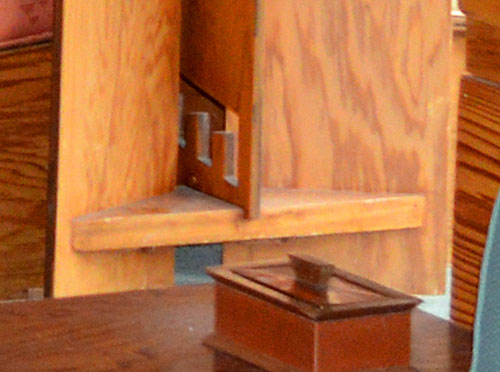 |
|
63E) Detail of the Wright
designed table. |
|
|
 |
|
63F) End tables mimic the
design of the larger dining tables. Chairs are placed in the
living room instead of built-in seating. |
|
|
|
|
|
Text and photographs by Douglas
M. Steiner, Copyright 2015. |
|
|
|
|
|


